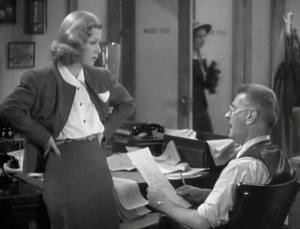
May 1938, Action Comics #1 appears on newsstands and ushers in both the Golden Age and the superhero genre, personified by Jerry Siegel and Joe Schuster’s toplined Superman. The character’s spectacular success led to the creation of dozens of heroes , all male until Charles Moulton Marston creates Wonder Woman. However, before Diana Prince, there stood Lois Lane, usually referred to as “Superman’s girlfriend”, but so much more. A hero with no powers who has endured as long as the Man of Steel himself.

Lois Lane influence Torchy Blaine has a discussion with her editor.
Siegel and Schuster used two models for their heroine. One is the movie character Torchy Blaine, a smart, pert, big city reporter, portrayed by actress Glenda Farrell in seven crime solving films from 1937 to 1939. The second inspiration is Nellie Bly (nee Elizabeth Jane Cochran), a real-life reporter for the New York World who, most famously, recreated the journey described in Jules Verne’s “Around the World in Eighty Days”.* So the character of Lois is intelligent, brave, feisty, and highly ambitious, her determination to succeed sometimes getting her into trouble from which Superman then extricates her.

Lois first appearance sets the tone for her relationship with Clark Kent.
Though she finds herself attracted to Superman she resents the competition presented by Clark, as well as being disgusted with his less than heroic personality. Like Wonder Woman she quickly becomes a strong feminist icon.

In Superman #28 (May – June ’44) Lois got her own strip with Superman nowhere in sight, but usually in mind. The first story sees her sent to get the scoop on a man threatening to jump off the eighth-floor ledge of an apartment building. When all else fails (“… 23 cops, 18 firemen, and seven psychiatrists have tried …” she’s told) Lois figures the siyuation needs “the woman’s touch”. She discovers that the Jumper is out there because of a love affairgone sour; he bought his girl a box of nougats and she fed them to her dog. An angry Loisdescribes the guy as “brainless” and stamps her foot, which causes the ledge under her to break. She manages to grab an election banner, but that ripse; her next stop is the first of several awnings that don’t hold up either. Lois finally reaches the ground where police are waiting with a net. All the way down, she keeps hoping Superman will appear. He doesn’t, but as Jimmy Olsen comments: ” You’re terrific, even without Superman.” As for the Jumper,her fall convinces him not to follow her: “I might have injured myself.”

One of the recurring motifs of the saga is Lois suspecting that Clark Kent and Superman are the same person and trying to prove it. Some people believe this started in the early 40’s, but only one story (‘Superman #17 (Jul. – Aug. 1941)) deals with this plot device.** Superman #67 (Nov. – Dec. 1950) got things rolling with ‘Superman’s Twin’, a tale involving Lois spotting Clark enter a doorway and Superman come out. Meanwhile, across town, Joe Poleski, an ironworker and Clark’s exact duplicate, is heading to work when a falling box from a passing truck strikes his head. He develops amnesia and a doctor who comes to his aid identifies him as Clark Kent, Daily Planet reporter, After a hospital check-up, Joe reports for work at the Planet where Lois stops him as he enters and accuses him of being Superman, while the real Superman watches. An uncertain Joe determines to find out if he is the Man of Steel by jumping out a window; Superman manages to land him safely without being seen, and Joe is now convinced. Superman determines to keep up the charade for a while to benefit Joe, because: ” … confusion of identity can be harmful to a victim of amnesia.” Unfortunately for Lois this Clark is obnoxious and uses Superman’s powers to scoop her on big stories. The climax finds everyone at a construction site where a test of a new concrete wall building machine is taking place. Two crooks, escaping a jewel robbery and chased by Superman/Joe, commandeer the machine and drop the concrete on a crowd of onlookers, hoping to distract their pursuer(s). Superman saves the crowd and captures the crooks, however. Lois is trappedby a blob of the quick drying cement. Joe calls in the story before freeing her and a furious Lois pitches a rock at his head, knocking him down. A lump develops that convinces her Clark is not Superman, and that he made her think Clark was, so she’d stop chasing after his identity. Coincidentally, the blow restores Joe’s memory.

Both Lois and Wonder Woman’s strong personalities received a dampening during the Silver Age. The feisty, career-minded Lois was replaced by a lovesick girl. Nothing exemplifies this more than the series “Superman’s Girl Friend, Lois Lane”***, which debuted in 1958.
Lois spends much of the book’s run trying to get Superman to marry her (while Steve Trevor keeps trying to convince Wonder Woman), fending off romantic rivals such as Lana Lang, or attempting to prove Clark is Superman. Fortunately, in the late 60’s, early 70’s, both Lois and Diana Prince regained their Golden Age stature.
* Lois also duplicates the journey in ‘Superman’ #49 (Nov. – Dec. 1947) using only land and sea transportation. She refuses any help from Superman, so he secretly aids her along the way.
** Clark’s admittedly ludicrous disguise of glasses and the occasional hat has been the subject of much discussion. An Internet search on ‘Superman’s disguise’ will bring up some interes- ting theories.
*** The book was one of the most popular of the era, consistently placing in the top ten best sellers list.


